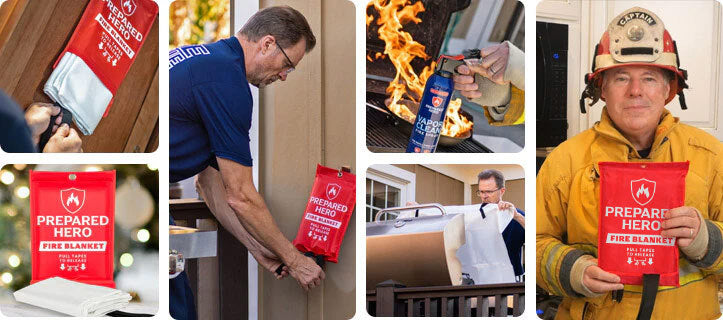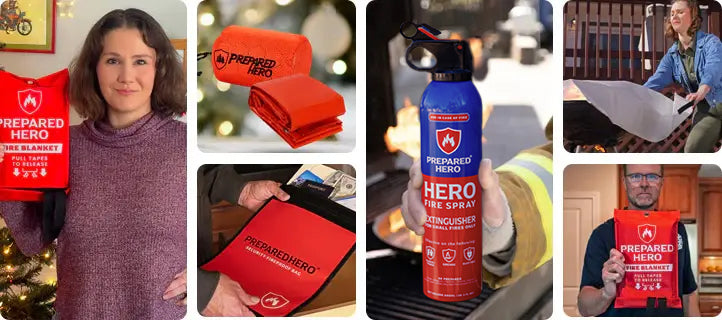Where you put your smoke detectors matters just as much as installing them. Proper placement makes sure they can detect...
Safety & Preparedness Blog
Running a busy commercial kitchen means juggling a lot, and one mistake can cost you everything. This is where NFPA...
Dryers make our lives easier, but they’re also a fire hazard. About 2,900 dryer fires in residential buildings are reported...
Fire safety isn’t just about big industrial hazards. It’s also about the everyday, seemingly safe stuff around us. From paper...
If you’ve ever sat around a campfire, you know how annoying smoke can be. This is where smokeless fire pits...
Combustible materials are common, but many people don’t realize how dangerous they can be under certain conditions. While they need...
Air duct cleaning improves indoor air quality, reduces allergens like dust and pollen, and helps eliminate odor. However, it can...
Carbon monoxide (CO) is a colorless, odorless, and tasteless gas that can build up in your home. Even small amounts...
Not all extinguishers work the same way. Carbon dioxide (CO2) fire extinguishers are designed for fires involving flammable liquids and...
One of the most dangerous but least understood fire events is a backdraft. Unlike a regular fire that burns openly,...
Fire alarms and smoke detectors play a huge role in keeping your home and workplace safe. But installing them can...
Ventilation is a big deal when it comes to commercial kitchens. The right hood doesn’t just keep the air clear....
Commercial kitchen hoods keep kitchens safe, clean, and up to code. They pull out smoke, heat, steam, and grease so...
Fire safety standards play a huge role in keeping buildings and the people inside them safe. One of these codes...
Roadside emergencies can happen when you least expect them, and being unprepared only makes things worse. A roadside emergency kit...
While they might all look alike, what’s inside a fire extinguisher varies depending on the type of fire they’re meant...
Proper ventilation is crucial in commercial kitchens. This is where Type 1 hoods come in. They’re made to handle grease,...
Preparing for emergencies at school doesn’t have to be hard. From first-aid basics to extra snacks and hygiene items, packing...
Plugging things into a wall outlet seems harmless, but how you do it matters. Many people don’t think twice about...
Gas leaks are more common than people think, and they can be dangerous if not handled properly. Even a small...
Space blankets may look like simple shiny sheets, but they’re useful. First introduced by NASA (National Aeronautics and Space Administration),...
Keeping a workplace or commercial space safe isn’t just about having fire alarms and sprinklers. It’s also about having the...
Smoke detectors are your first line of defense against devastating fires. According to the NFPA (National Fire Protection Association), the...
Parking near a fire hydrant might seem harmless if you’re only stopping for a few minutes, but there are rules...
An emergency action plan (EAP) helps people stay safe when things go wrong. It outlines how to prevent problems, prepare...
Hardwired smoke detectors are a smart choice for keeping your home safe. As the term suggests, they’re hardwired to your...
HEPA filters have a reputation for keeping indoor air cleaner, but what sets them apart from other filters? If you’ve...
Keeping your home safe from fire and carbon monoxide starts with having the right detectors. They give you the early...
The Solo Stove Bonfire has gained popularity for many reasons. Whether you’re planning to get one or already have one,...
Fire extinguishers may look similar, but they’re not designed for the same fire. Each type is made to put out...
Dryers make our lives easier, but they catch lint. That soft, dusty stuff might seem harmless, but letting it build...
Emergencies can happen anytime, and when they do, having a plan makes a huge difference. An emergency action plan (EAP)...
Propane fire pits are becoming more popular for many reasons. But what exactly is a propane fire pit? How does...
Fire alarms keep us safe, but they can be annoying when they beep nonstop with no fire in sight. While...
Fire safety is more than just having the right tools. It’s also about knowing what burns and how fast it...
Cooking oil is a kitchen staple, and knowing how to handle it is a must for your kitchen and the...
Bake fluid might not be in the spotlight, but it plays a big role in keeping your engine safe. It...
Space heaters can be a simple way to warm up a chilly room, but they also come with some risks...
Dust builds up fast, contaminates your air, and puts your health at risk. If you're wondering whether an air purifier...
Gas fire pits are among the top choices for outdoor settings and for many reasons. They’re easy to use, maintain,...
A flashover, also known as rapid fire progress (RFP), is one of the most dangerous types of fire. According to...
Changing your smoke detector battery might seem like a small task, but it’s a big deal for safety. Whether you’re...
Fire pits are great for hanging out, roasting marshmallows, or staying warm during cold nights. But before you light yours...
According to the NFPA (National Fire Protection Association), fire departments respond to an average of 346,800 home fires each year....
A fireplace gives warmth and a relaxing ambiance, but you should prioritize safety above all. Whether you’re using a wood...
Different emergencies call for different vehicles, and fire departments have different fire trucks for specific jobs. Some carry water, others...
Hydraulic fluid keeps machines running smoothly, but it is risky. Whether you're dealing with forklifts, vehicles, or heavy machinery, knowing...
Air purifiers are becoming an essential in many homes, especially those dealing with allergies or pet dander. But how do...
Space heaters are handy during cold weather, but they can set you back if you’re not careful. Knowing how space...
A fire prevention plan isn't just about responding to emergencies. It starts with being ready to deal with the fire....
Where you put your smoke detectors matters just as much as installing them. Proper placement makes sure they can detect...
Running a busy commercial kitchen means juggling a lot, and one mistake can cost you everything. This is where NFPA...
Dryers make our lives easier, but they’re also a fire hazard. About 2,900 dryer fires in residential buildings are reported...
Fire safety isn’t just about big industrial hazards. It’s also about the everyday, seemingly safe stuff around us. From paper...
If you’ve ever sat around a campfire, you know how annoying smoke can be. This is where smokeless fire pits...
Combustible materials are common, but many people don’t realize how dangerous they can be under certain conditions. While they need...
Air duct cleaning improves indoor air quality, reduces allergens like dust and pollen, and helps eliminate odor. However, it can...
Carbon monoxide (CO) is a colorless, odorless, and tasteless gas that can build up in your home. Even small amounts...
Not all extinguishers work the same way. Carbon dioxide (CO2) fire extinguishers are designed for fires involving flammable liquids and...
One of the most dangerous but least understood fire events is a backdraft. Unlike a regular fire that burns openly,...
Fire alarms and smoke detectors play a huge role in keeping your home and workplace safe. But installing them can...
Ventilation is a big deal when it comes to commercial kitchens. The right hood doesn’t just keep the air clear....
Commercial kitchen hoods keep kitchens safe, clean, and up to code. They pull out smoke, heat, steam, and grease so...
Fire safety standards play a huge role in keeping buildings and the people inside them safe. One of these codes...
Roadside emergencies can happen when you least expect them, and being unprepared only makes things worse. A roadside emergency kit...
While they might all look alike, what’s inside a fire extinguisher varies depending on the type of fire they’re meant...
Proper ventilation is crucial in commercial kitchens. This is where Type 1 hoods come in. They’re made to handle grease,...
Preparing for emergencies at school doesn’t have to be hard. From first-aid basics to extra snacks and hygiene items, packing...
Plugging things into a wall outlet seems harmless, but how you do it matters. Many people don’t think twice about...
Gas leaks are more common than people think, and they can be dangerous if not handled properly. Even a small...
Space blankets may look like simple shiny sheets, but they’re useful. First introduced by NASA (National Aeronautics and Space Administration),...
Keeping a workplace or commercial space safe isn’t just about having fire alarms and sprinklers. It’s also about having the...
Smoke detectors are your first line of defense against devastating fires. According to the NFPA (National Fire Protection Association), the...
Parking near a fire hydrant might seem harmless if you’re only stopping for a few minutes, but there are rules...
An emergency action plan (EAP) helps people stay safe when things go wrong. It outlines how to prevent problems, prepare...
Hardwired smoke detectors are a smart choice for keeping your home safe. As the term suggests, they’re hardwired to your...
HEPA filters have a reputation for keeping indoor air cleaner, but what sets them apart from other filters? If you’ve...
Keeping your home safe from fire and carbon monoxide starts with having the right detectors. They give you the early...
The Solo Stove Bonfire has gained popularity for many reasons. Whether you’re planning to get one or already have one,...
Fire extinguishers may look similar, but they’re not designed for the same fire. Each type is made to put out...
Dryers make our lives easier, but they catch lint. That soft, dusty stuff might seem harmless, but letting it build...
Emergencies can happen anytime, and when they do, having a plan makes a huge difference. An emergency action plan (EAP)...
Propane fire pits are becoming more popular for many reasons. But what exactly is a propane fire pit? How does...
Fire alarms keep us safe, but they can be annoying when they beep nonstop with no fire in sight. While...
Fire safety is more than just having the right tools. It’s also about knowing what burns and how fast it...
Cooking oil is a kitchen staple, and knowing how to handle it is a must for your kitchen and the...
Bake fluid might not be in the spotlight, but it plays a big role in keeping your engine safe. It...
Space heaters can be a simple way to warm up a chilly room, but they also come with some risks...
Dust builds up fast, contaminates your air, and puts your health at risk. If you're wondering whether an air purifier...
Gas fire pits are among the top choices for outdoor settings and for many reasons. They’re easy to use, maintain,...
A flashover, also known as rapid fire progress (RFP), is one of the most dangerous types of fire. According to...
Changing your smoke detector battery might seem like a small task, but it’s a big deal for safety. Whether you’re...
Fire pits are great for hanging out, roasting marshmallows, or staying warm during cold nights. But before you light yours...
According to the NFPA (National Fire Protection Association), fire departments respond to an average of 346,800 home fires each year....
A fireplace gives warmth and a relaxing ambiance, but you should prioritize safety above all. Whether you’re using a wood...
Different emergencies call for different vehicles, and fire departments have different fire trucks for specific jobs. Some carry water, others...
Hydraulic fluid keeps machines running smoothly, but it is risky. Whether you're dealing with forklifts, vehicles, or heavy machinery, knowing...
Air purifiers are becoming an essential in many homes, especially those dealing with allergies or pet dander. But how do...
Space heaters are handy during cold weather, but they can set you back if you’re not careful. Knowing how space...
A fire prevention plan isn't just about responding to emergencies. It starts with being ready to deal with the fire....
Where you put your smoke detectors matters just as much as installing them. Proper placement makes sure they can detect...
Running a busy commercial kitchen means juggling a lot, and one mistake can cost you everything. This is where NFPA...
Dryers make our lives easier, but they’re also a fire hazard. About 2,900 dryer fires in residential buildings are reported...
Fire safety isn’t just about big industrial hazards. It’s also about the everyday, seemingly safe stuff around us. From paper...
If you’ve ever sat around a campfire, you know how annoying smoke can be. This is where smokeless fire pits...
Combustible materials are common, but many people don’t realize how dangerous they can be under certain conditions. While they need...
Air duct cleaning improves indoor air quality, reduces allergens like dust and pollen, and helps eliminate odor. However, it can...
Carbon monoxide (CO) is a colorless, odorless, and tasteless gas that can build up in your home. Even small amounts...
Not all extinguishers work the same way. Carbon dioxide (CO2) fire extinguishers are designed for fires involving flammable liquids and...
One of the most dangerous but least understood fire events is a backdraft. Unlike a regular fire that burns openly,...
Fire alarms and smoke detectors play a huge role in keeping your home and workplace safe. But installing them can...
Ventilation is a big deal when it comes to commercial kitchens. The right hood doesn’t just keep the air clear....
Commercial kitchen hoods keep kitchens safe, clean, and up to code. They pull out smoke, heat, steam, and grease so...
Fire safety standards play a huge role in keeping buildings and the people inside them safe. One of these codes...
Roadside emergencies can happen when you least expect them, and being unprepared only makes things worse. A roadside emergency kit...
While they might all look alike, what’s inside a fire extinguisher varies depending on the type of fire they’re meant...
Proper ventilation is crucial in commercial kitchens. This is where Type 1 hoods come in. They’re made to handle grease,...
Preparing for emergencies at school doesn’t have to be hard. From first-aid basics to extra snacks and hygiene items, packing...
Plugging things into a wall outlet seems harmless, but how you do it matters. Many people don’t think twice about...
Gas leaks are more common than people think, and they can be dangerous if not handled properly. Even a small...
Space blankets may look like simple shiny sheets, but they’re useful. First introduced by NASA (National Aeronautics and Space Administration),...
Keeping a workplace or commercial space safe isn’t just about having fire alarms and sprinklers. It’s also about having the...
Smoke detectors are your first line of defense against devastating fires. According to the NFPA (National Fire Protection Association), the...
Parking near a fire hydrant might seem harmless if you’re only stopping for a few minutes, but there are rules...
An emergency action plan (EAP) helps people stay safe when things go wrong. It outlines how to prevent problems, prepare...
Hardwired smoke detectors are a smart choice for keeping your home safe. As the term suggests, they’re hardwired to your...
HEPA filters have a reputation for keeping indoor air cleaner, but what sets them apart from other filters? If you’ve...
Keeping your home safe from fire and carbon monoxide starts with having the right detectors. They give you the early...
The Solo Stove Bonfire has gained popularity for many reasons. Whether you’re planning to get one or already have one,...
Fire extinguishers may look similar, but they’re not designed for the same fire. Each type is made to put out...
Dryers make our lives easier, but they catch lint. That soft, dusty stuff might seem harmless, but letting it build...
Emergencies can happen anytime, and when they do, having a plan makes a huge difference. An emergency action plan (EAP)...
Propane fire pits are becoming more popular for many reasons. But what exactly is a propane fire pit? How does...
Fire alarms keep us safe, but they can be annoying when they beep nonstop with no fire in sight. While...
Fire safety is more than just having the right tools. It’s also about knowing what burns and how fast it...
Cooking oil is a kitchen staple, and knowing how to handle it is a must for your kitchen and the...
Bake fluid might not be in the spotlight, but it plays a big role in keeping your engine safe. It...
Space heaters can be a simple way to warm up a chilly room, but they also come with some risks...
Dust builds up fast, contaminates your air, and puts your health at risk. If you're wondering whether an air purifier...
Gas fire pits are among the top choices for outdoor settings and for many reasons. They’re easy to use, maintain,...
A flashover, also known as rapid fire progress (RFP), is one of the most dangerous types of fire. According to...
Changing your smoke detector battery might seem like a small task, but it’s a big deal for safety. Whether you’re...
Fire pits are great for hanging out, roasting marshmallows, or staying warm during cold nights. But before you light yours...
According to the NFPA (National Fire Protection Association), fire departments respond to an average of 346,800 home fires each year....
A fireplace gives warmth and a relaxing ambiance, but you should prioritize safety above all. Whether you’re using a wood...
Different emergencies call for different vehicles, and fire departments have different fire trucks for specific jobs. Some carry water, others...
Hydraulic fluid keeps machines running smoothly, but it is risky. Whether you're dealing with forklifts, vehicles, or heavy machinery, knowing...
Air purifiers are becoming an essential in many homes, especially those dealing with allergies or pet dander. But how do...
Space heaters are handy during cold weather, but they can set you back if you’re not careful. Knowing how space...
A fire prevention plan isn't just about responding to emergencies. It starts with being ready to deal with the fire....
Where you put your smoke detectors matters just as much as installing them. Proper placement makes sure they can detect...
Running a busy commercial kitchen means juggling a lot, and one mistake can cost you everything. This is where NFPA...
Dryers make our lives easier, but they’re also a fire hazard. About 2,900 dryer fires in residential buildings are reported...
Fire safety isn’t just about big industrial hazards. It’s also about the everyday, seemingly safe stuff around us. From paper...
If you’ve ever sat around a campfire, you know how annoying smoke can be. This is where smokeless fire pits...
Combustible materials are common, but many people don’t realize how dangerous they can be under certain conditions. While they need...
Air duct cleaning improves indoor air quality, reduces allergens like dust and pollen, and helps eliminate odor. However, it can...
Carbon monoxide (CO) is a colorless, odorless, and tasteless gas that can build up in your home. Even small amounts...
Not all extinguishers work the same way. Carbon dioxide (CO2) fire extinguishers are designed for fires involving flammable liquids and...
One of the most dangerous but least understood fire events is a backdraft. Unlike a regular fire that burns openly,...
Fire alarms and smoke detectors play a huge role in keeping your home and workplace safe. But installing them can...
Ventilation is a big deal when it comes to commercial kitchens. The right hood doesn’t just keep the air clear....
Commercial kitchen hoods keep kitchens safe, clean, and up to code. They pull out smoke, heat, steam, and grease so...
Fire safety standards play a huge role in keeping buildings and the people inside them safe. One of these codes...
Roadside emergencies can happen when you least expect them, and being unprepared only makes things worse. A roadside emergency kit...
While they might all look alike, what’s inside a fire extinguisher varies depending on the type of fire they’re meant...
Proper ventilation is crucial in commercial kitchens. This is where Type 1 hoods come in. They’re made to handle grease,...
Preparing for emergencies at school doesn’t have to be hard. From first-aid basics to extra snacks and hygiene items, packing...
Plugging things into a wall outlet seems harmless, but how you do it matters. Many people don’t think twice about...
Gas leaks are more common than people think, and they can be dangerous if not handled properly. Even a small...
Space blankets may look like simple shiny sheets, but they’re useful. First introduced by NASA (National Aeronautics and Space Administration),...
Keeping a workplace or commercial space safe isn’t just about having fire alarms and sprinklers. It’s also about having the...
Smoke detectors are your first line of defense against devastating fires. According to the NFPA (National Fire Protection Association), the...
Parking near a fire hydrant might seem harmless if you’re only stopping for a few minutes, but there are rules...
An emergency action plan (EAP) helps people stay safe when things go wrong. It outlines how to prevent problems, prepare...
Hardwired smoke detectors are a smart choice for keeping your home safe. As the term suggests, they’re hardwired to your...
HEPA filters have a reputation for keeping indoor air cleaner, but what sets them apart from other filters? If you’ve...
Keeping your home safe from fire and carbon monoxide starts with having the right detectors. They give you the early...
The Solo Stove Bonfire has gained popularity for many reasons. Whether you’re planning to get one or already have one,...
Fire extinguishers may look similar, but they’re not designed for the same fire. Each type is made to put out...
Dryers make our lives easier, but they catch lint. That soft, dusty stuff might seem harmless, but letting it build...
Emergencies can happen anytime, and when they do, having a plan makes a huge difference. An emergency action plan (EAP)...
Propane fire pits are becoming more popular for many reasons. But what exactly is a propane fire pit? How does...
Fire alarms keep us safe, but they can be annoying when they beep nonstop with no fire in sight. While...
Fire safety is more than just having the right tools. It’s also about knowing what burns and how fast it...
Cooking oil is a kitchen staple, and knowing how to handle it is a must for your kitchen and the...
Bake fluid might not be in the spotlight, but it plays a big role in keeping your engine safe. It...
Space heaters can be a simple way to warm up a chilly room, but they also come with some risks...
Dust builds up fast, contaminates your air, and puts your health at risk. If you're wondering whether an air purifier...
Gas fire pits are among the top choices for outdoor settings and for many reasons. They’re easy to use, maintain,...
A flashover, also known as rapid fire progress (RFP), is one of the most dangerous types of fire. According to...
Changing your smoke detector battery might seem like a small task, but it’s a big deal for safety. Whether you’re...
Fire pits are great for hanging out, roasting marshmallows, or staying warm during cold nights. But before you light yours...
According to the NFPA (National Fire Protection Association), fire departments respond to an average of 346,800 home fires each year....
A fireplace gives warmth and a relaxing ambiance, but you should prioritize safety above all. Whether you’re using a wood...
Different emergencies call for different vehicles, and fire departments have different fire trucks for specific jobs. Some carry water, others...
Hydraulic fluid keeps machines running smoothly, but it is risky. Whether you're dealing with forklifts, vehicles, or heavy machinery, knowing...
Air purifiers are becoming an essential in many homes, especially those dealing with allergies or pet dander. But how do...
Space heaters are handy during cold weather, but they can set you back if you’re not careful. Knowing how space...
A fire prevention plan isn't just about responding to emergencies. It starts with being ready to deal with the fire....


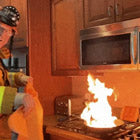 Fire
Fire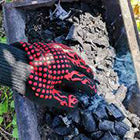 Safety
Safety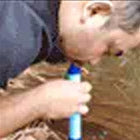 Survival
Survival Protection
Protection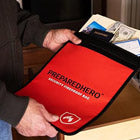 New
New Scouting America
Scouting America
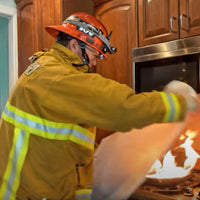 Fire
Fire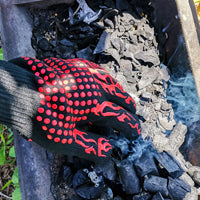 Safety
Safety Survival
Survival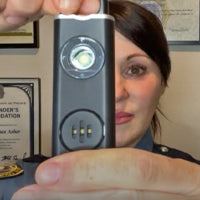 Protection
Protection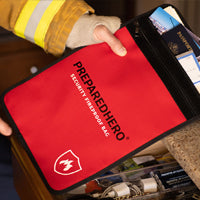 New
New
